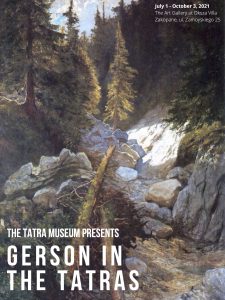Gerson in the Tatras exhibition
July 1 – October 3, 2021
The Tatra Museum in Zakopane welcomes you to the exhibition Gerson in the Tatra Mountains. Wojciech Gerson (1831-1901) is considered one of the most outstanding Polish landscape painters of the nineteenth century. He was fascinated by the landscape and people of the Tatras, which he depicted many times in his works. This exhibition is the first of its kind to show this aspect of his work. It is being held in the year 2021 which marks two significant anniversaries – the 190th anniversary of the artist’s birth and 120 years since his death. Also, this year the Tatra Museum has become an institution co-run by the Ministry of Culture, National Heritage and Sport.
Gerson was one of the leading representatives of Polish academic art. He won most recognition amongst his contemporaries and has been best known for his historical, religious, allegorical works and portraits. However, he is becoming increasingly valued as a fine painter of Tatra landscapes.
He began visiting the Tatras in the early 1860s, whilst on painting expeditions around the country with his friends, all graduates of the Warsaw School of Fine Arts. These young artists, who were interested in the renewal of landscape and genre painting through studies of nature, first visited the Tatra Mountains in 1860.
Gerson’s oil paintings from his first stay in the Tatra Mountains (Resting in a shepherd’s hut, 1862; Highlander children, 1868; Highlander children at play, 1867) were mainly genre scenes in which the landscape largely acted as a background. These works already display his knowledge of the landscape and the excellent workmanship of an experienced draughtsman and illustrator. Gerson’s landscape sketches and watercolours from that period were little known at the time, as they were never exhibited. Despite the artist’s career taking a different course, in his own words his expeditions to the Tatras “provided a treasure trove of experience and skills for a lifetime.”
He returned to landscape painting only in the final decades of the nineteenth century, when he started visiting the Tatra Mountains again. The artist’s daughter, Maria Gerson-Dąbrowska, remembered that “Gerson travelled to the Tatra Mountains almost every summer between 1885 and 1900. If he could not go for the whole summer, he would just go for three or four weeks. He simply could not live without the Tatra Mountains, he longed for them and always welcomed them with the same delight and joy… Gerson painted Tatra landscapes until the final years of his life, always painting them in his studio in Warsaw from studies he had made, sometimes just faint sketches and notes and also from memory.” The artist’s daughter also mentions that in the Tatra Mountains the painter sought themes in secluded places, off the beaten track. Despite a serious illness, he reached remote mountain peaks and hidden places, never using photography as a substitute for studies directly from nature.
In the late 1880s, Gerson’s painting became distinguished by mature realism and an individual style. It was, however, in the 1890s that his most outstanding Tatra landscapes were created: A Pile of Rocks in the Biała Woda Valley, 1892; A dried-up stream bed in the Tatra Mountains, 1893 and Cemetery in the mountains, 1894.
Wojciech Gerson – a life-long social activist – occupied himself not only with art, but also the cultural life of Zakopane and the activities of the visiting intelligentsia. He witnessed the creation of the Tatra Museum and even donated several of his drawings and ethnographic items to this institution. We are proud to present at the exhibition those works donated by Gerson and selected examples of the items that have enriched our ethnographic collection.
Gerson also participated in meetings related to the creation of the great Tatra Panorama (1896). He and Walery Eljasz were consulted on the artistic side of this undertaking, and even participated in a reconnaissance expedition (on August 28, 1894) to the summit of Miedziana. This was chosen by Eljasz as the viewpoint from where the Tatra Mountains were to be painted. As a teacher, Gerson was interested in the School of Wooden Crafts operating in Zakopane.
Gerson’s strong character inspired members of the following generation. Contemporary artists also refer to his works and unique legacy. Therefore this exhibition also includes a small annexe, which presents contemporary references to Gerson as one of the most outstanding of Polish landscape painters.



